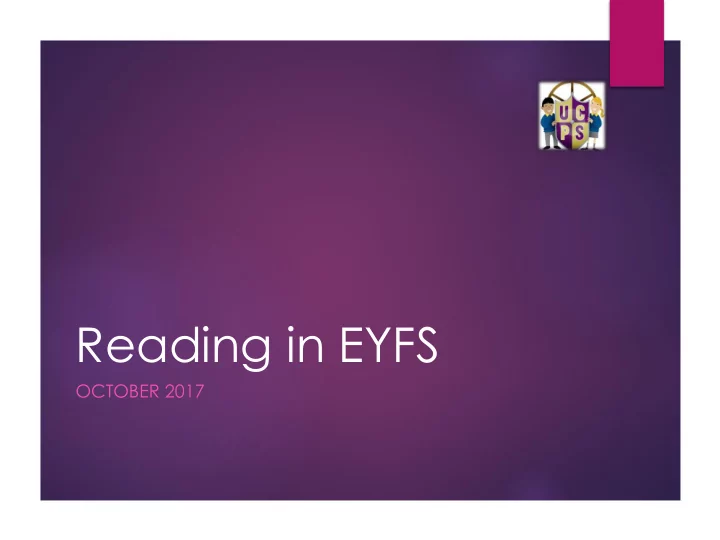

Reading in EYFS OCTOBER 2017
What is Batty Phonics? A program for teaching letter sounds. Order the letters are taught: 1. i, l, t, u, y 2. c, o, a, d, g, q, e 3. h, n, m, r, b, p, k 4. v, w, x 5. z, j, f, s Each letter sound has a story and action
Why have we chosen this approach? Large movements support formation Crazy stories stick in children’s minds Order means that writing can be supported at the same time
What happens during each session? “Let’s fly to the Land of Batty Basics.” Session is split into 4 sections
Revisit and Review Flash card letters (lower and uppercase) Guess the letter from the action Stations game
Hear it, say it, see it Read new story and act out Find letter in environment Sound bingo Sound bag
C There once was a crazy farmer called Collin. He had a strange farm yard. He kept 7 cats, 5 cockerels, 3 canaries, 42 caterpillars and 2 crocodiles. He even had an orchard full of coconut trees. But his favorite animals, the ones he loved more than any other, was cows. Big ones, small ones, some as big as you! They were all milking cows and he loved to milk them. He sat on his special stool and called them to him. “Come, come, come, come, come” cccccccc cccccccccc cccccccccc Action: Motion waving someone towards you “ come,come,come and milk the cow.” “ ccccccccc, ccccccccccc .”
Practise and Apply Odd one out Match letter to object Can you think of something beginning with... Complete the sentence
Letter formation Formation rhyme and picture Magic finger Sensory writing Formation on paper and handwriting
How is this learning supported through free choice activities? Magnetic letters to find and order Treasure hunt & cooking Challenge questions around the room Writing on different surfaces Splat the superhero with the right sound Tricky word wall outdoors Chalking on the ground Magnifying glasses and writin g
What happens in Reception? Letter formation Digraphs (sh) and Trigraphs (igh) Letter names Linking lowercase to capital High Frequency Words HFW Tricky words Common exception words (the, I, to, go) Letters-words-sentences
How can you help at home? Take home packs Spotting letters Encouraging mark making- give it a purpose Listening for sounds Rhythm and Rhyme Alliteration Environmental sounds Music Letter formation
Guided Reading Guided reading is 'small-group reading instruction designed to provide differentiated teaching that supports students in developing reading proficiency' Inference Story language Comprehension Explore possibilities Read aloud, think aloud RIC
Home School Book Every child should now have a reading book. This should be brought in daily and will be changed when your child can read it confidently. The book going home should have an element of challenge. i.e. something to practise Give your child specific praise: I love the way you... Your praise → they should continue to apply Supplement with books from the library and home. Read to your child every night – your child has more chance of learning to read ‘naturally’ if they hear good, regular modelling at school and at home. Ask lots of comprehension questions to check their understanding. How, What, Why questions?
The Basics Does your child know Words, Sentences, Pages all go left to right? Letters → Words → Sentences → Next line → left to right page Can they spot inversions of Letters in a word? (magnetic letters) Words in a sentence? (cut-up sentence) Lines? (cut-up sentence)
Go through the book with your child (not read!) Look at the pictures and talk about what is happening. Select sentences and practise with the correct expression. Discuss the punctuation with your child. What is this called? What is it for? e.g. Come along Off you go then! “Mum!” shouted Anna. Dad said, “I can see you!” Mum asked, “Have you found your teddy?” I have looked everywhere for my teddy. Where are you? Teach ‘tricky’ vocabulary e.g. laughed, noticed Then let your child read the book to you. Hopefully they will remember the things you have discussed in your introduction to the book!
. Good Modelling and Practise Its quality not quantity we are looking for! Reading should sound like you are ‘talking.’ Read alternate pages – sustains fluency and lets the child hear what good reading sounds like. Re-read books/pages/chapters. Getting stuck: Have a go. Adult prompt: What could that word be? What would fit? Does that make sense? Go back and re-read the sentence – can you guess it now? Over sounding-out stops comprehension of the story
Sharing your child’s journey Speaking: Children express themselves effectively, showing awareness of listeners’ needs. They use past, present and future forms accurately when talking about events that have happened or are to happen in the future. They develop their own narratives and explanations by connecting ideas or events. Reading: Children read and understand simple sentences. They use phonic knowledge to decode regular words and read them aloud accurately. They also read some common irregular words. They demonstrate an understanding when talking with others about what they have read. Write in reading record Upload to @UPC_EYFS on Twitter
Questions?
Recommend
More recommend